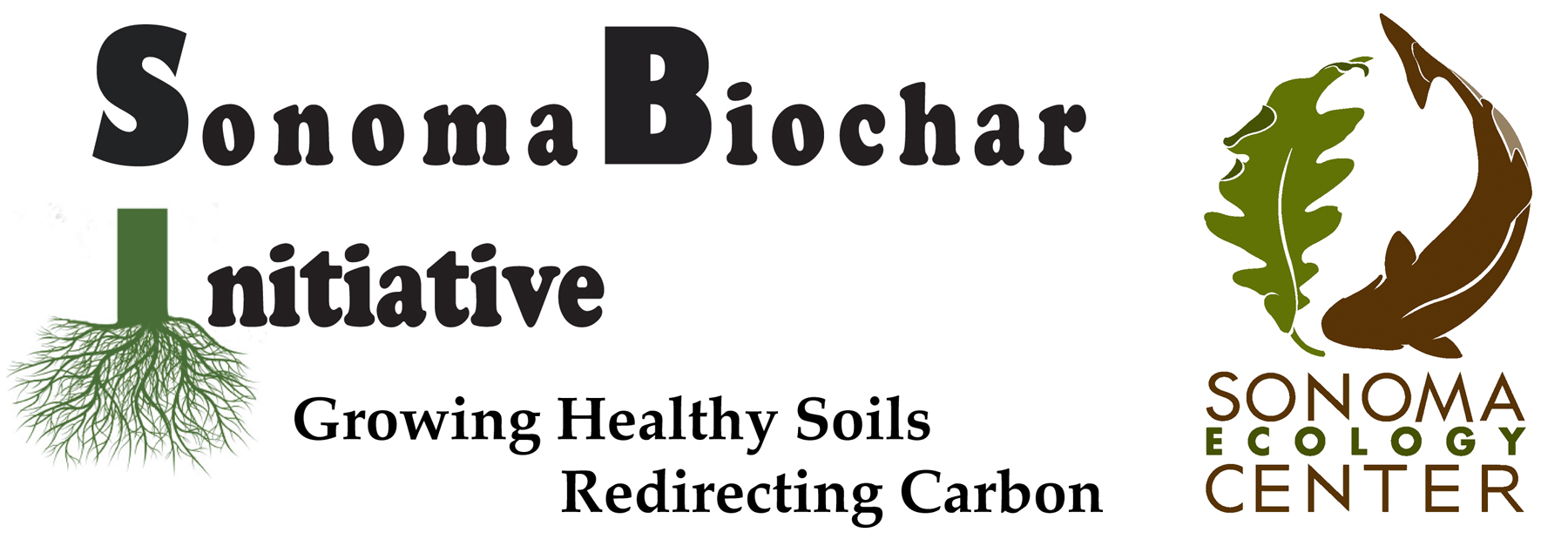2023 Highlights
2023 was a busy year for those of us in the biochar industry and we continue to see growth in research, production, education, and use. We were active in all of these areas in 2023 and we’re looking forward to another busy year in 2024. Here are some highlights from the biochar program at Sonoma Ecology Center:

Emissions Testing in the Usal Forest, Mendocino
Presentations on Biochar to Cal Poly and Northern Sac Valley APCD’s
We gave two major presentations this year, one to an excellent online webinar series called Climate Solutions Nowproduced by Cal Poly; and an in-person conference sponsored by the Sacramento Valley Basinwide Air Pollution Control Council, an organization that represents 9 different air districts in northern California. This group was primarily interested in alternative technologies and strategies for biomass utilization that could replace open burning of crop and forestry residues if and when open burning is banned throughout the state.
CAL FIRE Green Schoolyards Grant Program
The Sonoma Ecology Center was awarded two planning grants as part of CAL FIRE’s Green Schoolyards Urban Forestry program. In partnership with landscape designers Bay Tree Design and Gates and Associates, architect DCA, tree care company A Plus Tree, and the Pittsburg and Bellevue school districts, we will be determining where shade trees can be planted, where blacktop could be replaced with more natural elements and play areas, where outdoor classrooms could be built, and where water elements like bioswales or water catchment systems could be installed. Biochar will of course be included in all of the plantings to reduce water needs, to decrease tree mortality, and to sequester carbon to increase the carbon sequestration requirements of the grants. These are one-year grants, at the end of which we will be applying for follow-on implementation grants if funding is available.
Earth Foundries EBRPD Biochar Use-Case Study
We worked as consultants on a biochar use-case study for Earth Foundries (EF), a for-profit organization dedicated to demonstrating and developing methods for sustainable and ecological forestry and reducing wildfire risk. EF received a contract from the East Bay Regional Park District (EBRPD) to reduce the number of Eucalyptus trees in an overgrown 80-acre forest in Chabot Regional Park, using Forester Dan Falk’s Tigercat Carbonator to process the materials. The Carbonator was chosen for the project because it is designed to process up to 15 tons of whole logs on-site rather than having to truck bulky logs or chipped material through Oakland neighborhoods, and because it is also designed to produce biochar.

The Tigercat Carbonator (V1) processes Eucalyptus at Chabot Regional Park.
The biochar was used in a number of local field studies, including a greenwaste compost trial at the Napa Recycling and Compost Center and Compost/Biochar emissions study at poultry and dairy farms in Sonoma County. A bioswale field trial is also getting underway at Veggielution, an urban farm in the South Bay.
Blending biochar into poultry manure windrows.
Emissions Testing for Low-Tech Biochar Production Methods
As profiled in another blog post, we spent two weeks in the Usal Forest managing air emissions testing for the San Luis Obispo Air Quality Management District’s CAL FIRE grant. 8 days of testing was conducted by the U.S. Forest Service Fire Science Lab on standard burn piles compared to conservation burn piles and the Ring of fire flame cap kiln. Early results indicate significant reductions in methane and C02 emissions for the conservation burn and kiln methods, and especially for the kilns. A full report will be issued by the Lab in February and it will be available here, so check back.

Flame-cap kiln burn emissions testing.
A second two week round of testing will be done in June at the Fire Science Lab in Missoula, Montana, with results from that project due later in the year. A life cycle analysis for the projects are also being conducted by Jim Amonette of Washington State University.
Continued Working on Permitting for ARTi Pyrolysis Unit
We have also continued to work on permitting issues for our CAL FIRE funded pyrolysis operation scheduled to be sited at the Napa Recycling and Compost facility in American Canyon. We have unfortunately been working on this for almost 3 years now and we will hopefully learn soon if we will be able to receive an Authority to Construct permit from the Bay Area Air Quality Management District, which will require an exemption from the EPA EEEE regulations that are part of Title V permits. Having to adhere to these expensive and onerous regulations designed for large-scale municipal solid waste facilities would make small-scale pyrolysis operations like ours un-economical. We have appealed for an exemption for small-scale facilities like our as we are only processing clean, surplus woodchips that would otherwise be landfilled into a valuable agricultural product, biochar, that also has significant carbon sequestration potential if scaled.
Joined Advisory Committee for NCRP Biomass Aggregation Pilot Project Managed by Forestree Collective/Green Valley Farm and Mill
We were asked to join an advisory committee for a pilot project to study whether a biomass aggregation center could be opened and profitably operated in Sonoma County. This project, funded by the North Coast Resource Partnership, was in turn funded by the Governor’s Office of Planning and Research (OPR) as part of 5 such studies throughout northern California.
And lastly, we trained 167 people in the field on the use of kilns and conservation burning method for reducing smoke and emissions.

Donut Biochar Training
All Photos Copyright Raymond Baltar